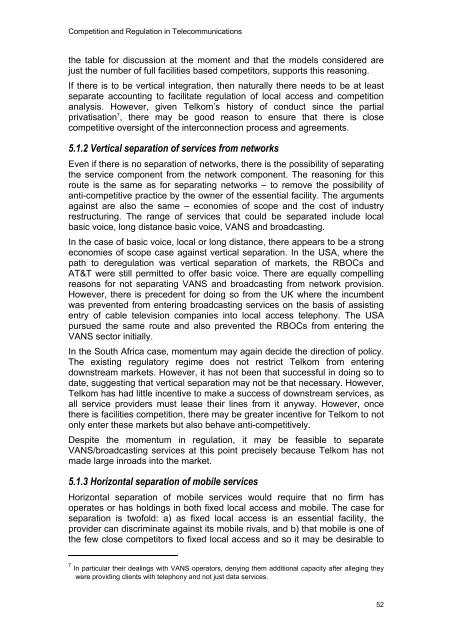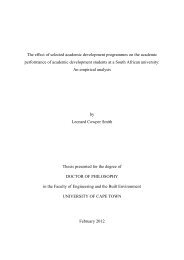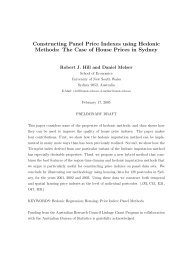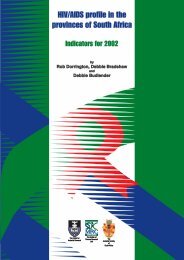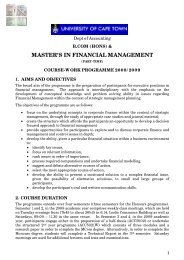Competition and Regulation in the Telecommunications Industry in ...
Competition and Regulation in the Telecommunications Industry in ...
Competition and Regulation in the Telecommunications Industry in ...
Create successful ePaper yourself
Turn your PDF publications into a flip-book with our unique Google optimized e-Paper software.
<strong>Competition</strong> <strong>and</strong> <strong>Regulation</strong> <strong>in</strong> <strong>Telecommunications</strong><strong>the</strong> table for discussion at <strong>the</strong> moment <strong>and</strong> that <strong>the</strong> models considered arejust <strong>the</strong> number of full facilities based competitors, supports this reason<strong>in</strong>g.If <strong>the</strong>re is to be vertical <strong>in</strong>tegration, <strong>the</strong>n naturally <strong>the</strong>re needs to be at leastseparate account<strong>in</strong>g to facilitate regulation of local access <strong>and</strong> competitionanalysis. However, given Telkom’s history of conduct s<strong>in</strong>ce <strong>the</strong> partialprivatisation 7 , <strong>the</strong>re may be good reason to ensure that <strong>the</strong>re is closecompetitive oversight of <strong>the</strong> <strong>in</strong>terconnection process <strong>and</strong> agreements.5.1.2 Vertical separation of services from networksEven if <strong>the</strong>re is no separation of networks, <strong>the</strong>re is <strong>the</strong> possibility of separat<strong>in</strong>g<strong>the</strong> service component from <strong>the</strong> network component. The reason<strong>in</strong>g for thisroute is <strong>the</strong> same as for separat<strong>in</strong>g networks – to remove <strong>the</strong> possibility ofanti-competitive practice by <strong>the</strong> owner of <strong>the</strong> essential facility. The argumentsaga<strong>in</strong>st are also <strong>the</strong> same – economies of scope <strong>and</strong> <strong>the</strong> cost of <strong>in</strong>dustryrestructur<strong>in</strong>g. The range of services that could be separated <strong>in</strong>clude localbasic voice, long distance basic voice, VANS <strong>and</strong> broadcast<strong>in</strong>g.In <strong>the</strong> case of basic voice, local or long distance, <strong>the</strong>re appears to be a strongeconomies of scope case aga<strong>in</strong>st vertical separation. In <strong>the</strong> USA, where <strong>the</strong>path to deregulation was vertical separation of markets, <strong>the</strong> RBOCs <strong>and</strong>AT&T were still permitted to offer basic voice. There are equally compell<strong>in</strong>greasons for not separat<strong>in</strong>g VANS <strong>and</strong> broadcast<strong>in</strong>g from network provision.However, <strong>the</strong>re is precedent for do<strong>in</strong>g so from <strong>the</strong> UK where <strong>the</strong> <strong>in</strong>cumbentwas prevented from enter<strong>in</strong>g broadcast<strong>in</strong>g services on <strong>the</strong> basis of assist<strong>in</strong>gentry of cable television companies <strong>in</strong>to local access telephony. The USApursued <strong>the</strong> same route <strong>and</strong> also prevented <strong>the</strong> RBOCs from enter<strong>in</strong>g <strong>the</strong>VANS sector <strong>in</strong>itially.In <strong>the</strong> South Africa case, momentum may aga<strong>in</strong> decide <strong>the</strong> direction of policy.The exist<strong>in</strong>g regulatory regime does not restrict Telkom from enter<strong>in</strong>gdownstream markets. However, it has not been that successful <strong>in</strong> do<strong>in</strong>g so todate, suggest<strong>in</strong>g that vertical separation may not be that necessary. However,Telkom has had little <strong>in</strong>centive to make a success of downstream services, asall service providers must lease <strong>the</strong>ir l<strong>in</strong>es from it anyway. However, once<strong>the</strong>re is facilities competition, <strong>the</strong>re may be greater <strong>in</strong>centive for Telkom to notonly enter <strong>the</strong>se markets but also behave anti-competitively.Despite <strong>the</strong> momentum <strong>in</strong> regulation, it may be feasible to separateVANS/broadcast<strong>in</strong>g services at this po<strong>in</strong>t precisely because Telkom has notmade large <strong>in</strong>roads <strong>in</strong>to <strong>the</strong> market.5.1.3 Horizontal separation of mobile servicesHorizontal separation of mobile services would require that no firm hasoperates or has hold<strong>in</strong>gs <strong>in</strong> both fixed local access <strong>and</strong> mobile. The case forseparation is twofold: a) as fixed local access is an essential facility, <strong>the</strong>provider can discrim<strong>in</strong>ate aga<strong>in</strong>st its mobile rivals, <strong>and</strong> b) that mobile is one of<strong>the</strong> few close competitors to fixed local access <strong>and</strong> so it may be desirable to7 In particular <strong>the</strong>ir deal<strong>in</strong>gs with VANS operators, deny<strong>in</strong>g <strong>the</strong>m additional capacity after alleg<strong>in</strong>g <strong>the</strong>ywere provid<strong>in</strong>g clients with telephony <strong>and</strong> not just data services.52


